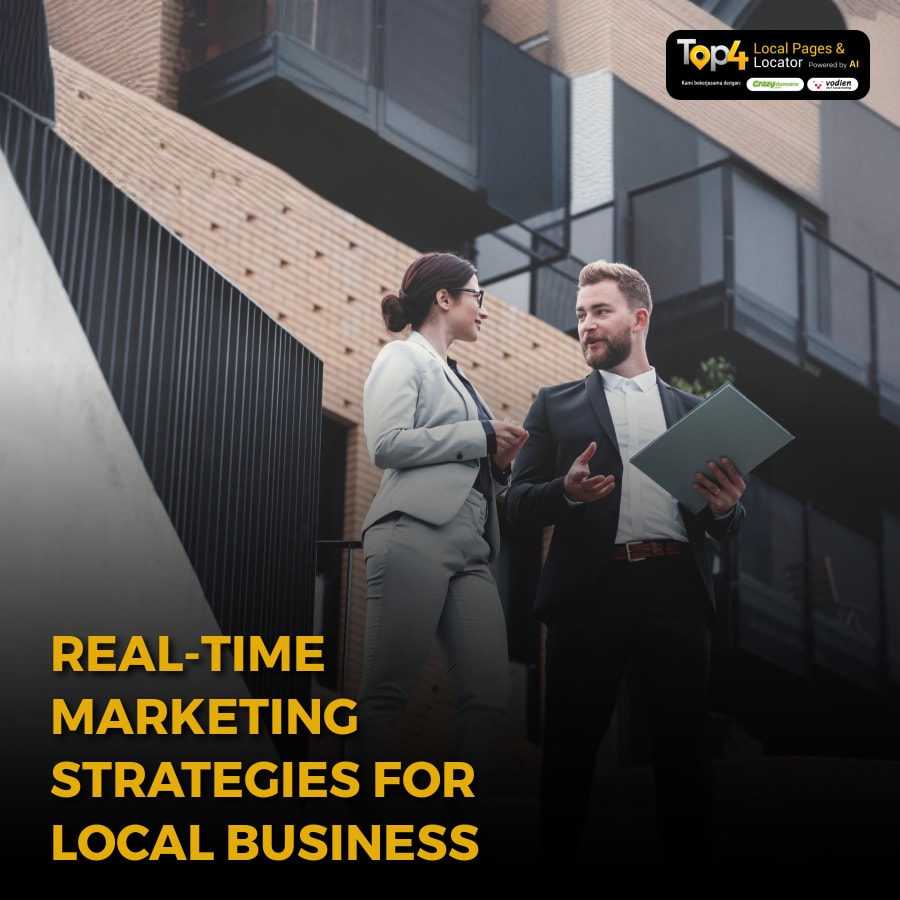Did you know that January 30th is National Croissant Day? This day is frequently used by pastry shops around the nation to increase sales and engagement with creative real-time marketing campaigns. Think tempting photos of flaky croissants, "croissant selfie" contests, or even flash sales on their signature pastries. This isn't just a random idea; it's a smart strategy that taps into the power of real-time marketing. Unlike traditional marketing strategies that rely on predetermined schedules and static content, real-time marketing requires businesses to be agile and responsive, seizing opportunities as they arise. It's about capitalising on trending topics, news events, and even local happenings to create marketing messages that feel timely and relevant.
If you’re looking for increased engagement, personalisation, and brand authenticity, then real-time marketing deserves a closer look. It helps businesses—especially those with multiple locations or franchises—build stronger, more relevant, and more authentic bonds with customers. This article provides a practical guide to implementing real-time marketing strategies for local businesses and franchises, helping them harness the power of the "right now" to boost their brand and drive customer engagement.
What's Real-Time Marketing All About?
Real-time marketing involves creating and deploying marketing tactics that respond instantly to current events, trends, and consumer behaviors. It's about being alert and adaptable, using tools and technologies to monitor what's happening in your industry and the world around you. But it's more than just reacting quickly; it's about understanding your audience and engaging with them in a way that feels timely and relevant.
Think of it as having a conversation with your customers. Instead of planning every word in advance, you're listening to what they're saying and responding in a way that's natural and engaging. This could involve:
- Jumping on trending hashtags: When a relevant hashtag is trending on social media, create content that aligns with the conversation and uses the hashtag to increase visibility.
- Reacting to breaking news: If a news event impacts your industry or community, acknowledge it and share your perspective or offer support.
- Participating in relevant discussions: Engage in online conversations that are relevant to your audience and brand, offering valuable insights or opinions.
The key is to be present, attentive, and responsive, creating a sense of immediacy and connection with your audience.
Why Real-Time Marketing Matters to Local Businesses
Real-time marketing offers a significant advantage for local businesses and franchises. It allows them to connect with their audience in a way that feels immediate, relevant, and engaging. Here are some key benefits:
- Increased Customer Engagement: When a business responds to current events or local trends, it shows attentiveness and relatability. Imagine a local bookstore promoting a book signing event with an author who's suddenly trending on social media, or a cafe offering a "rainy day discount" during a sudden downpour. These timely actions show customers that you're paying attention to their needs and interests, fostering a deeper connection and making them feel heard and valued.
- Enhanced Brand Image: Real-time marketing positions businesses as proactive, innovative, and in tune with their community. For example, a local restaurant that quickly shares a social media post expressing support for a community fundraiser not only demonstrates social responsibility but also builds a positive brand image. This can lead to increased trust and brand loyalty.
- Greater Reach and Visibility: By tapping into trending topics and conversations, you can expand your brand's reach beyond your usual followers. For instance, a local clothing store that uses a trending hashtag related to a popular fashion event can gain visibility from a much wider audience. This increased exposure can lead to new customers and greater brand awareness.
- Improved Customer Relationships: Real-time interactions create a sense of community and foster a two-way dialogue with your customers. Responding to comments, answering questions, and participating in relevant conversations shows that you value your customers' input and are invested in building relationships. This encourages repeat business and fosters a loyal customer base.
- Competitive Advantage: In a crowded marketplace, real-time marketing can help you stand out from the competition by showcasing your responsiveness and ability to connect with your audience on a personal level. When customers see that you're engaged and responsive, they're more likely to choose you over a competitor who isn't as active or attentive.
Local businesses can use real-time marketing to create a dynamic and engaging online presence that connects with their target audience and drives business growth.
Implementing Real-Time Marketing in Your Strategy
Real-time marketing requires a combination of preparation and adaptability. It's about having a solid foundation while remaining flexible enough to seize opportunities as they arise. Knowing what real-time marketing is, the next step is implementation.To start, businesses need to utilise robust social listening tools. Here's how to execute it effectively:
- Define Your Goals and Target Audience:
Before diving into real-time marketing, it's crucial to have a clear understanding of what you want to achieve. Are you aiming to increase brand awareness, drive website traffic, generate leads, or boost sales? Defining your objectives will help you measure the success of your real-time marketing efforts.
Equally important is identifying your target audience. Who are you trying to reach with your real-time marketing messages? What are their interests, demographics, and online behaviors? Understanding your audience will guide your content creation and platform choices. For example, if you're targeting a younger demographic, you might focus on platforms like TikTok or Instagram, while a B2B business might find more success on LinkedIn.
- Set Up a Monitoring System:
Real-time marketing requires you to be in tune with what's happening in your industry and the world around you. This means staying informed about current events, trending topics, and industry news.
To effectively monitor the digital landscape, utilize social listening tools. These tools allow you to:
- Track relevant keywords and hashtags: Stay informed about conversations and trends related to your brand, industry, or competitors.
- Monitor news sources and blogs: Receive alerts about breaking news and industry developments that could present real-time marketing opportunities.
- Analyse social media sentiment: Gauge public opinion and identify potential PR crises or positive opportunities for engagement.
- Create a Flexible Content Plan:
While a content calendar is essential for long-term planning, real-time marketing demands flexibility. Your content calendar should be a guide, not a rigid set of rules. Be prepared to adapt and adjust your planned content to incorporate timely and relevant topics.
For example:
- Social media posts: Create quick posts that react to trending hashtags or news events.
- Website updates: Add a banner or news section to your website to highlight timely information or promotions.
- Email marketing: Send out a quick email blast to your subscribers about a flash sale or limited-time offer related to a current event.
- Advertising campaigns: Adjust your ad copy or targeting to align with trending topics or seasonal events.
The key is to strike a balance between planned content and spontaneous reactions, allowing yourself the flexibility to capitalize on real-time opportunities.
- Act Quickly and Decisively:
Real-time marketing opportunities are often fleeting. Trends come and go, news cycles move quickly, and consumer attention spans are short. When you spot a chance to engage with your audience in a timely way, it's crucial to act quickly. Hesitation can mean missing out on the moment.
Here's how to seize the opportunity:
- Have a plan in place: While you can't predict every real-time marketing opportunity, having a general plan can help you react quickly. This might include pre-approved messaging for common scenarios, a list of go-to content formats, or designated team members responsible for real-time marketing execution.
- Monitor trends and conversations: Use social listening tools and stay informed about current events to identify potential real-time marketing opportunities.
- Craft your message: Keep your message concise, relevant, and engaging. Align it with your brand voice and values.
- Create your content: Whether it's a quick social media post, a blog update, or an email blast, create content that's optimized for the platform and your target audience.
- Share it while it's hot: Don't wait too long to share your content. The key is to be timely and capitalize on the current buzz.
- Prioritize Customer Engagement:
Real-time marketing is not a one-way street. It's about building relationships and fostering a two-way dialogue with your audience.
Here's how to prioritize engagement:
- Respond to comments and messages promptly: Show your audience that you're listening and that you value their input.
- Answer questions and address concerns: Be helpful and informative, providing value to your audience.
- Participate in relevant conversations: Join discussions on social media and other platforms, offering your insights and perspective.
- Show appreciation for your audience: Thank your followers for their engagement and support.
- Use a conversational tone: Avoid overly formal or promotional language. Be authentic and relatable.
By prioritising customer engagement, you can create a loyal community around your brand and foster a sense of belonging.
- Optimize Your Online Presence:
Before you dive into real-time marketing, ensure your online presence is up-to-date and optimised for local search. This creates a strong foundation for your real-time efforts.
Here's what to focus on:
- Website: Ensure your website is mobile-friendly, easy to navigate, and contains relevant information about your business, products, and services.
- Online listings: Claim and optimize your business listings on Google My Business and other relevant directories. Ensure your NAP (Name, Address, Phone number) information is consistent across all platforms.
- Google Business Profile: Complete your Google Business Profile with accurate information, engaging photos, and recent customer reviews. Use Google Posts to share timely updates and promotions.
By optimising your online presence, you make it easier for customers to find you online and engage with your brand. This sets the stage for successful real-time marketing campaigns.
Monitoring and Measuring Success
For any marketing strategy, assessment is vital. It's essential to monitor the effectiveness of real-time marketing efforts. Use analytics to track increased engagement rates, conversions, and overall user interaction levels post-interaction. These metrics provide a picture of how well the strategies have performed and offer insights that will refine future endeavours.
Conclusion
Real-time marketing offers a powerful way for businesses to connect with their audience in a meaningful and engaging way. By being responsive, adaptable, and attuned to current events and trends, businesses can cut through the noise and capture the attention of their target audience. This approach fosters stronger customer relationships, enhances brand image, and ultimately drives business growth.
Whether it's through timely social media posts, engaging with trending hashtags, or participating in relevant conversations, real-time marketing allows businesses to stay top-of-mind and build a loyal community around their brand. Remember, success in real-time marketing requires a combination of preparation and flexibility. Establish a monitoring system, create a flexible content plan, and be ready to act quickly when opportunities arise.
At Top4 Marketing, our expertise can help you craft a local marketing plan that aligns with your business goals and local community needs. Let us assist you in maximising your online strategy. Visit Top4 Marketing blog for more insights to elevate your business to new heights. Contact us today and start your journey towards local marketing success.


 SAUDI ARABIA
SAUDI ARABIA

























